 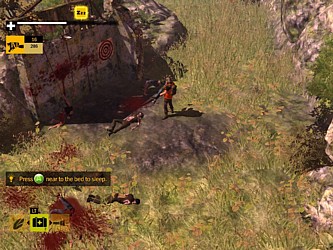
In recent years, zombies have enjoyed a surge in media popularity - everything from books, TV shows, movies, and video games have featured the shambling undead humanoids that hunger for living flesh. So, it's no surprise that Survival Horror games are not only maintaining their own popularity, but are beginning to show influence on other genres. How to Survive is more or less a Diablo clone with many elements of the Survival Horror genre, most notably the limited inventory space, potential to run out of ammo (though refills are quite plentiful), and of course, endless hordes of zombies. Unlike the pre-Resident Evil 4 games, which typically had awkward "tank"-like controls, How to Survive features fluid movement, as well as the ability to level up your characters with experience points accumulated from defeating foes, finding special items, and completing quests. It's a marriage of genres that was bound to happen, and How to Survive competently executes it, all with a twisted, though sometimes juvenile, sense of humor.
 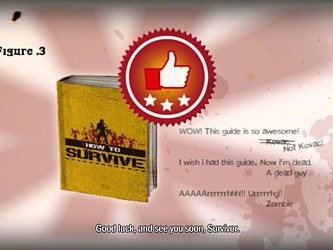
After choosing one of three characters with varying stats and special skills, you awaken as the lone survivor of a shipwreck on a presumably uncharted island. What you learn almost immediately is that the island is infested with hordes of zombies, so continuing to survive won't just be a matter of finding food, water, and shelter (although you'll need to do that, too). You'll also have to craft some weapons from whatever items you can scavenge, be it a humble wooden stick or an impromptu machine gun kitbashed from spare and rather unlikely parts. It's like Lost, if there was only one survivor and the island had zombies instead of a Smoke Monster.
As you begin exploring your new surroundings, you'll happen across strange cards and pamphlets that have been strewn about here and there that teach you how to build items, armor, and weapons, or how to handle the various dangers of the island. These appear to have been written, often with a tongue-in-cheek sense of humor, by an enigmatic masked man named Kovac, who talks in a Romanian accent that might bring to one's mind common movie and TV show depictions of Dracula. Kovac seems disturbingly overjoyed at your predicament, as it gives him a chance to impart his survival wisdom to someone in what seems like some kind of bizarre "test market" experiment for selling his "How to Survive" book, for which the game has been named.
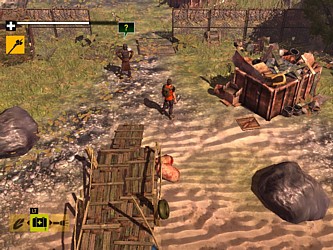 
As you hack and slash your way through the zombie hordes, you'll discover that not only is the island just one in an archipelago of four, each progressively larger and full of more hazards than the last, but there are a few other survivors sparesly living on them. One of them is a one-legged man named Ramon who devises a plan to escape the islands on a moored pontoon plane - if only you can find some parts needed to repair it, as well as a pilot. Another is the mysterious masked Kovac, himself, who lives in a one-man trailor park surrounded by a junkyard full of useful items, from which he continues to impart knowledge in his incongruently optimistic manner.
So, your entire mission becomes finding a means to repair that seaplane and fly it off the islands before you become a zombie's lunch. Movement about the islands is similar in both style and perspective to Diablo - that overhead, semi-isometric view with hack'n'slash combat that became popular in many RPG, adventure, and action games ever since Diablo's rise to gaming stardom. Like many RPGs, killing enemies earns experience points, and like particularly oldschool RPGs (Might and Magic comes to mind), sometimes you'll get a generous experience point boost for completing a major quest. This reinforces the likelihood that you'll be leveled up enough to reasonably take on the game's current difficulty level as the challenges increase the farther you go.
 
How to Survive also grants its characters one skill point per each level gain. These can be used to learn a new ability from a preset "skill tree", which differ slightly per character. While everyone starts off by learning to set fires, only Kenji can learn to make a crossbow, only Jack can make a scoped gun, and only Abby can gain the ability to deal more damage to enemies at night (yes, the game has day/night cycles, complete with realistic shadows).
But skill and level boosts are only one-half of the story. Armor and better weapons will need to be obtained, but don't expect to buy them in shops. They must be crafted from items found scattered about the island. The game's innovative combining system allows you to join two or more items together to form a possibly more useful one. This allows you to not only create more powerful armor, but to build better axes, bows, guns, and even everyone's favorite monster-devouring weapon, chainsaws. You can experiment as much as you want since (most) combined items can be uncombined back into their raw parts, and then re-combined. However, there's a catch...
 
Like many Survival Horror games, How to Survive's inventory capacity is extremely limited, relegating you to just 25 slots. So, you're going to have to be picky and choosy about what items you keep with you at all times, especially since there are times when you'll need room for required "quest" items, like those aforementioned parts to repair the plane. I learned from playing Resident Evil Zero that sometimes the best way to deal with this situation is to drop off items you don't immediately need, but might find useful later, in a spot where it's easy to recover them. Thankfully, How to Survive has a number of choice options, with my two preferred locations being the docks near the seaplane and Kovac's junkyard.
In some ways, How to Survive attempts to put the "Survival" in "Survival Horror" moreso than previous games in the genre. It's not just a matter of killing the undead before they kill you and being resourceful with your limited items and inventory. How to Survive actually has meters for "Hunger", "Thirst", and "Tiredness", which must be replenished by eating, drinking, and sleeping (or eating something that cures sleep).
While I don't mind having this extra bit of micromanagement to deal with, I'm rather thankful the game is generous in giving you options to ease the pressure. There is an abundance of edible goods on the island, plenty of wells to drink from (and some fruits cure both thirst and hunger), and there are options in the skill tree for all characters to slow down the rate at which these meters deplete. The one that has the biggest effect on the game is the Tiredness meter because it introduces an element of strategy and challenge...
 
The main way to cure a character's exhaustion is to find a shelter and sleep there. But pretty much all the shelters are locked when you first find them, and unlocking them sets off an alarm that summons a zombie horde, both from the interior of the shelter and the exterior, the likes of which will make any previous melee you've had look like a picnic. The relentless attack doesn't cease until the alarm does. Considering how ridiculously difficult it can be to outlast these situations, and they get harder with each progressive shelter you come across, I may not have been able to pass the most difficult ones had I not figured out a simple trick that made dealing with them more reasonable. If you want to know what it is, highlight: Close the door immediately after opening it to trap the zombies from within the shelter inside, then clear out the exterior zombies first. Reopen the door and finish off the remaining zombies after the alarm stops, or toss an explosive at them. The shelter will fill up so much, that occasionally a zombie or two will get "osmosed" through the door, but it's still better than dealing with both halves of the problem at once.
For those who think you can just get away with clearing and only using one shelter when needed, or relying on items that restore the Tiredness meter, think again. Necessary quest items are often hidden in those shelters. Another way in which exhausation plays a role in strategy is that sleep causes time to pass, which means if you're tired during the day, you might wake up at night. If you prefer to do less exploring at night, when it's harder to see and there are more monsters on the loose, you may opt to use an item that cures sleepiness instead.
 
Continuing your quest for the elusive plane parts will often find you running into other marooned characters who require you to find something for them before they'll help you, like you're the old woman trying to get her pig over the stile. These include a drunk, swearing drug smuggler, and a stereotypically "crazy old cat lady" whose quest might be somewhat off-putting to cat lovers. I'm just glad the cat is already dead when you find it. Considering the game's sense of humor tends to err on the side of tastelessness, it could've been worse.
Their demands often mean venturing into unexplored territories, but sometimes require backtracking. Usually what happens is that new enemies begin appearing where they weren't before, such as the fat zombies that explode on contact and therefore must be taken out with ranged weapons, or the stampeding ostrich flocks that can swarm and devour you in seconds. These alterations to the once-familiar terrain will likely cause you to rethink your strategies for traveling through them.
Circumstances heat up even more when boss monsters are suddenly placed in key locations, usually guarding a necessary quest item. The boss is always the same giant zombie, eventually fought once per island, and even serves as the game's final boss. Unfortunately, this is somewhat disappointing since even though each fight is incrementally harder, it's mostly because more zombie lackeys show up for them, which can be overwhelming, yes, but if you have enough goods to outlast them, then all you're left with is a boss that you already know how to defeat.
 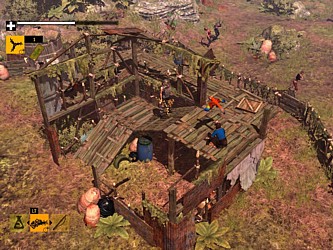
While How to Survive has challenging moments, I'm sure even those who have never completed a Survival Horror game before could finish it. Those who complain about the awkward controls of the original Resident Evil and games that (literally) followed in its footsteps will take right to the fluid controls of How to Survive, though it takes time to learn aiming properly (I should also note that I played it with a dual-analog controller, not a keyboard and mouse). Although you can run out of ammo, enemies drop it so often that it's easy to replenish it. Most healing plants regenerate after time, so if you don't mind "reharvesting" them when you run low, you'll never run out.
This is why it's a good thing How to Survive contains a harder difficulty setting, which is usually where the real challenge is at in Survival Horror games. However, while I thought the harder settings is what made Resident Evil Zero and Resident Evil 4 go from being good games to great games, How to Survive's "Iron Man" difficulty is only marginally harder than the Normal mode. Item drops are supposed to be fewer, but I didn't notice much difference. You take a lot more damage from enemies at first, but getting and upgrading armor negates the effect after awhile.
 
There is a Challenge Mode for those who want to get more out of the concept. Each challenge starts you out in a predetermined spot on one of the islands with no weapons or items (though if you take a character you built up in the Story Mode, their experience levels, skills, and armor will carry over). Using only what you can find, you must make your way through a specific situation to an airplane or boat to escape the island. One Challenge Mode, for example, has you working your way past a lot of exploding fat zombies; another one takes you through a "zoo" of undead animals. Sometimes you have to find parts to repair the boat/plane, and sometimes you don't. Upon beating these stages, you're given a rank of C-S, so you can replay them for higher ranks if you desire.
The game also includes achievements, optional sidequests, leaderboards, and 2-player modes if you care about that stuff for prolonging the experience. I enjoyed completing some of the challenges to earn the achievements, but eventually began to feel burnt out on them.
 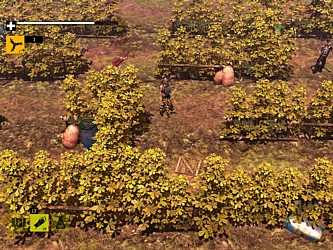
While the story does make an attempt to satire/parody the recent zombie trends, and maybe even The Zombie Survival Guide by Max Brooks in particular, the humor is often disappointingly juvenile. Yeah, it got a laugh out of me once in a great while (like the description of the leather bag), but poop jokes and liberal use of the F-word aren't endlessly hilarious. Perhaps the real humor is just in the nihilistic approach to the zombie carnage - heads and limbs can be chopped off, and if they fall onto a slope, they'll go rolling down it. You'd be surprised how long a severed head or arm can merrily roll along the beach.
As for the story...well, "repair the plane" is almost entirely it, and the plot twist involving Kovac near the end could be seen coming from a mile away (which is probably why there's a secondary, but more nonsensical twist in the ending).
At least the graphics and environments are gorgeous, with lots of strange, pleasant, and interesting details for explorers to look at. Sometimes I wish I could just wander through the forests and enjoy the scenery and sounds without having to worry so much about zombie attacks. The sound mostly consists of ambience, but major battles are scored with that orchestral/industrial hybrid music that's common to this genre (check out my music page if you want to hear some of it).
 
How to Survive normally costs $14.99 on Steam (and from what I can gather, it seems to be the same for the Xbox 360 and Playstation 3). Since I tend to be a cheapass gamer these days, I can't say with 100% certainty that the game is worth that price tag for everyone. I bought it in the Steam Winter Sale when it was down to less than $4, and I think if my review makes it sound interesting to you at all, and assuming you won't be offended by the violence and language, then I can easily recommend it for that price if it goes on sale again. I can't honestly say I didn't get my own $4 worth from it.
OVERALL
SCORE: 3.5/5
BACK TO PC
REVIEWS BACK TO MAIN
PAGE
|

